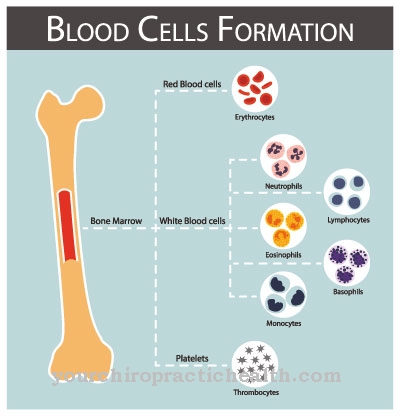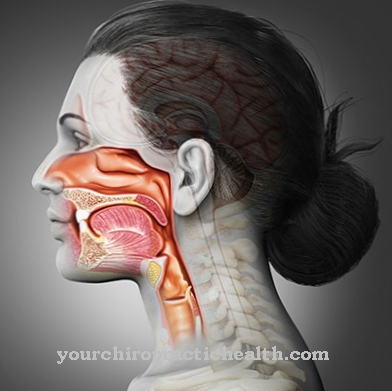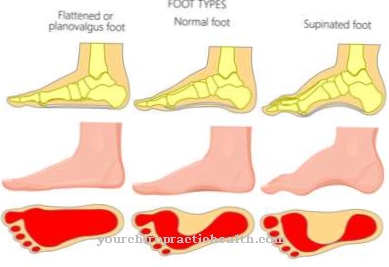A Appendicitis or appendicitis is an inflammation of the appendix or appendix. Typical signs of appendicitis are severe abdominal pain or abdominal pain when pulling up the legs, jumping, or applying pressure.
What is appendicitis?

Appendicitis is inflammation of the appendix caused by bacteria. This particularly leads to bacterial inflammation in the area of the appendix. The appendix itself is roughly the length of a thumb and ends in a dead end in the large intestine. In appendicitis, this two to twenty centimeter long appendix (also called appendicitis) is inflamed.
There are a large number of lymph nodes in the appendix area. If a bacterial infection or inflammation occurs, these lymph nodes swell and the appendix enlarges enormously. Appendicitis is relatively common and was hardly curable in the Middle Ages, so that affected people often died from it.
Today around seven percent of the German population suffer from appendicitis. Children and young adults (between the ages of ten and thirty) in particular can get an infection of the appendix. But it is also not uncommon for pregnant women to develop the appendix.
causes
The causes of appendicitis are diverse. The most common cause is a blockage of the appendix (appendix). Especially if the faeces or stool is hard and coarse-grained, this can lead to an occlusion of the appendix entrance. Due to the weight of the feces, the appendix can also buckle and become inflamed over the long term.
Another cause are worms or parasites. These occur less often, but then quickly develop inflammation in the appendix area. Adhesions on the intestinal walls are just as rare. As already noted, foreign bodies of any shape are particularly likely to be the cause. These include the well-known and typical cherry stones and other stones from pome fruit.
Finally, inflammation caused by various bacteria should be mentioned as the cause. Enterococci, E. coli bacteria or Proteus bacteria are known for this. They ignite the appendix without any closure or kinking. Inflammation of the intestine is also very rare in Crohn's disease, which can also lead to appendicitis.
Symptoms, ailments & signs
The first signs of appendicitis are usually non-specific pain in the stomach and belly button. A little later, they appear increasingly stabbing or pulling in the right lower abdomen. Typically, appendicitis causes pain when walking or hopping, which is why doctors also make patients hop on their right leg to diagnose.
In order to relieve the pain, those affected tend to pull their right leg towards the stomach, something doctors call this limping. Due to the pain and inflammation, the abdominal wall is tense and reacts to pressure with severe pain. In addition to the pain, there is an increase in body temperature to cica 39 degrees C, sometimes an increased pulse and sweating.
Serious temperature differences between measurements in the armpit and in the anus are typical of appendicitis. The pain can be accompanied by a lack of appetite, nausea, and vomiting. Symptoms can be more severe in children than in adults. You usually feel severe nausea and the pain extends over the entire abdomen.
In the elderly, the symptoms may be less severe and therefore not easily recognizable. They rarely have a fever. In pregnant women, pain often occurs in unusual areas due to the size of the abdomen, sometimes even in the back. This makes diagnosis difficult.
course
The course of appendicitis depends on whether it is recognized and treated in good time. If acute appendicitis is left untreated, it can even lead to death. Nevertheless, almost all cases are treated in the hospital, so that serious complications can almost never be assumed.
If the appendicitis is not treated or the appendix is not operated on, life-threatening complications can occur:
- Intestinal perforation or the appendix. If the appendix bursts, a so-called perforation occurs. The fecal residues are distributed into the interior of the abdomen, which can then cause further inflammation or poisoning. It can also lead to inflammation of the peritoneum and massive pus formation (abscesses).
- If the intestinal obstruction persists, intestinal paralysis can set in. If the stool or feces cannot be excreted with further food intake, intestinal perforations also occur.
Complications
Appendicitis or inflammation of the appendix (appendicitis) can cause serious complications. The bacterial inflammation of the appendix can cause it to turn red and swell. A lot of pus also accumulates. If this is not removed, there is a risk that it will burst and break through (perforation).
The pus pours into the abdomen and can infect the other abdominal organs such as the peritoneum (peritonitis). In addition, abscesses can form in the abdomen, which leads to severe abdominal pain and discomfort. Furthermore, the intestine can become paralyzed, the intestinal muscles no longer function properly and the food content is no longer transported, resulting in an intestinal obstruction (paralytic ileus).
If left untreated, this can lead to a rupture of the intestinal wall, which can then also become inflamed. The increased pressure that is created in the intestines also compresses vessels. This leads to an insufficient supply of the intestinal section, which can die. In addition, the lungs can be compressed, which disrupts breathing.
The metabolism is also disturbed, so that the body loses a lot of fluids and electrolytes. In patients with inflammatory bowel disease (Crohn's disease), connections between the appendix and other parts of the intestine, so-called fistulas, can form, which make the operation more difficult.
When should you go to the doctor?
At the first suspicion of appendicitis, a doctor should be consulted immediately, as there is danger to life. As soon as those affected notice a loss of appetite, nausea and vomiting, action is essential. Appendicitis is often associated with diarrhea and vomiting. Accompanied by colicky abdominal pain, these symptoms should be clarified in any case. You should also contact a doctor if you notice a coated tongue and a high fever.
In children and older people in particular, it is advisable to react immediately if appendicitis is suspected. In these patients, the symptoms are usually weaker and cannot be precisely assessed. Pregnant women should consult a doctor directly, as the appendix shifts due to pregnancy and makes a diagnosis more difficult.
The pain is initially noticeable in the area around the navel. In the next twelve hours, the symptoms spread to the right lower abdomen.Contact a doctor after these symptoms at the latest. Anyone who also experiences vibration pain when running and hopping shouldn't worry about visiting the doctor.
Doctors & therapists in your area
Treatment & Therapy
If the typical symptoms of appendicitis occur (severe abdominal pain, abdominal pain when pulling the legs and after applying pressure), a doctor should be consulted immediately. In acute cases, calling an emergency doctor should not be avoided.
If appendicitis is suspected, the person concerned is admitted to hospital. During this time, the patient is not allowed to eat anything, otherwise complications can arise during the operation under general anesthesia. During the appendix operation, the inflamed appendix is then removed. The earlier this happens, the faster healing or recovery is possible.
In the past, this appendix operation was performed with the help of an abdominal incision. It was not uncommon for wound infections to occur. Today there is more and more going towards performing appendectomy with an invasive surgical method.
An endoscope is inserted through a tiny cut or opening near the appendix. This keyhole surgery has the advantage of finding the cause of appendicitis more quickly and not creating large wounds. In addition, further examinations or differential diagnoses can be carried out.
Outlook & forecast
For many doctors, operations on the appendix are a routine procedure. Only the time of diagnosis therefore decides whether the appendicitis is potentially harmless or threatening. If the inflamed appendix is completely removed, usually no significant consequential damage remains. However, if the real cause is identified too late, serious complications can arise.
If an intestinal perforation occurs, feces, bacteria and pus pass through the brittle intestine into the surrounding abdominal cavity. As a direct consequence, this leads to an extremely painful and rapid inflammation of the peritoneum (peritonitis). The abdominal wall hardens shortly after the incident and a flat sensation of pain over the entire abdominal area occurs.
The life-threatening condition is considered an acute emergency and the patient's demise can only be prevented by prompt intervention. Even without a breakthrough, in advanced stages, deposits in the form of abscesses can form in more distant sections of the intestine. Long-term inflammation and restricted or even blocked bowel activity make the recovery process more difficult.
In some cases, pain in the right lower abdomen will go away on its own without medical attention. However, slight appendicitis leaves scarred tissue and protuberances on the affected areas. This change in the intestinal surface can provoke the development of new inflammations if they are unfavorable and also cause functional disorders. After successful removal of the appendage, an antibiotic treatment kills residual germs, depending on the severity of the appendicitis.
Usually, patients can drink and eat solid food again one day after the end of treatment. The so-called Douglas abscess can, however, make it necessary to remove newly formed pus a week after the operation.
Aftercare
To be on the safe side, a slight appendicitis or irritation should be marked as healed or not requiring an operation by a follow-up examination. In most cases, however, acute appendicitis will experience a different type of follow-up. If the inflammation is already well advanced, the inflamed appendix must be surgically removed. Since acute appendicitis can lead to a rupture of the appendix and its contents, including pus, to empty into the abdomen, the operation is usually unavoidable in the advanced stage.
In the postoperative follow-up care not only the wound care is ensured. Laporoscopically performed operations can also cause painful sequelae such as bruising in the abdomen. The doctor treating you must keep an eye on larger bruises. In addition, the inflammation may have already progressed. It must be ensured that it has not also grabbed the surrounding tissue.
The scar pain after an inflamed and removed appendix can initially be considerable because of severed abdominal muscles. The recently operated patient should therefore be made aware that he has to take it easy for a longer period of time. He is usually on sick leave. Aftercare ensures that there are neither wound infections nor internal inflammatory processes.
There are also certain consequential risks. Surgical removal of the appendix can lead to later ectopic pregnancies, increased risk of colon cancer or postoperative bowel obstruction.
You can do that yourself
With regard to the following self-help measures, it is expressly pointed out that appendicitis can be a medical emergency and must be treated by a doctor.
But the complaints can be reduced through self-help measures. Castor oil used as a poultice can loosen existing constipation and prevent inflammatory processes. Oral intake can stimulate bowel movements and accompanying digestive disorders can be alleviated.
The gingerols contained in ginger are considered to be strong anti-inflammatory. In addition, ginger can reduce any nausea and improve appetite. Freshly brewed ginger should be drunk two to three times a day. Let it brew freshly for about 10 minutes. Additionally rub the belly with ginger oil.
Fenugreek seeds can prevent the build-up of intestinal waste and excess mucus. These seeds can have preventive and acute anti-inflammatory effects. They can also relieve existing pain. For a brew, boil two teaspoons of fenugreek seeds with a cup of water and simmer for about 10 to 15 minutes. Then strain and drink lukewarm once a day.



























